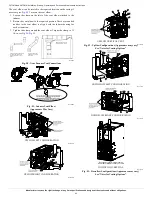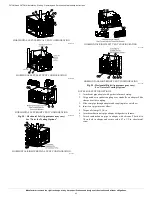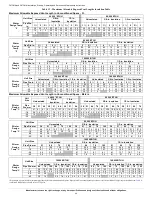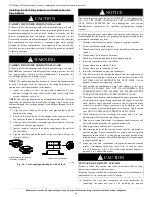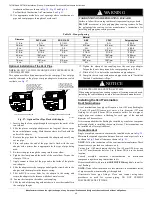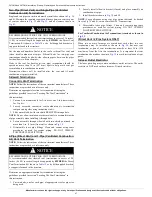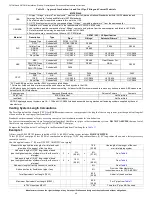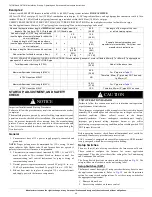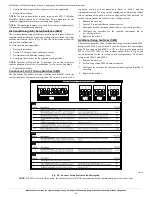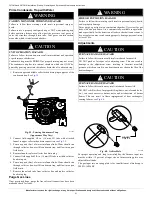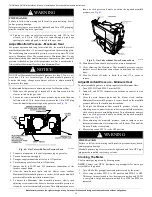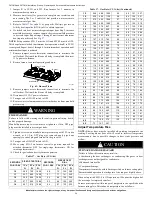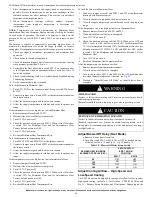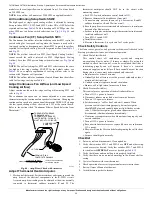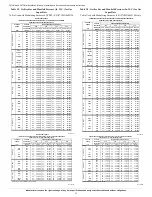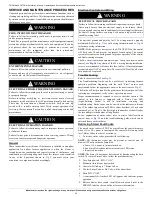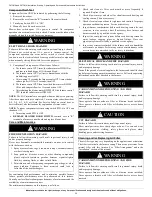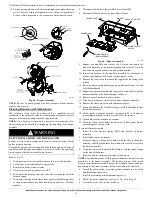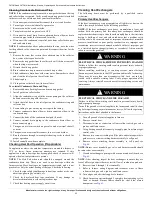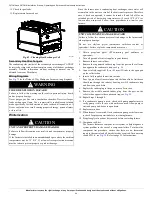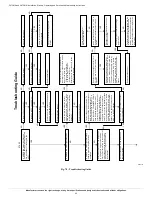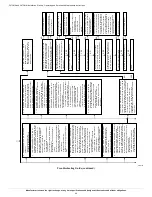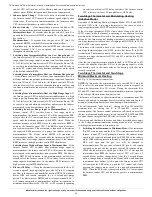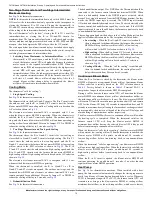
F97CMN and G97CMN: Installation, Start-up, Operating and Service and Maintenance Instructions
Manufacturer reserves the right to change, at any time, specifications and designs without notice and without obligations.
56
model size, the cooling airflow can be adjusted from 1.5 to 6 tons based
on 350 CFM ton.
NOTE:
6 ton airflow will truncate at 2200 CFM on applicable models.
Air Conditioning Setup Switch SW2
The high-speed or single-speed cooling airflow is adjusted by turning
Setup switches SW2-1, SW2-2 and SW2-3 either ON or OFF. Select the
. Table is based upon 350 CFM per ton. For
other CFM per ton Setup switch selections, see
,
.
Continuous Fan (CF) Setup Switch SW3
The Continuous Fan airflow selection via Setup switches SW3 is also the
switch setting for low-speed cooling when the furnace is used with a
two-speed cooling or heat pump unit. Adjust SW3 to match the airflow
required for low-speed cooling. Select the required airflow from
and
.
NOTE:
The airflow selected via SW3 (Low-Speed Cooling Airflow)
cannot exceed the airflow selected via SW2 (High-Speed Cooling
Airflow). For other CFM per ton Setup switch selections, see
.
NOTE:
The airflow settings for SW2 and SW3 selections are the same
for high and low stage cooling, EXCEPT for the default values, see
. For a complete explanation of cooling airflow, refer to the
section titled “Sequence of Operation.”
NOTE:
The airflow table for continuous fan is different than the airflow
table for low stage cooling, see
Adjust Continuous Fan Airflow (and Low-Speed
Cooling Airflow)
Adjust continuous fan and low-stage cooling airflow using SW3 and
The continuous fan speed can be further adjusted at a conventional
thermostat using the continuous fan speed select function. Changing the
continuous fan speed at a conventional thermostat DOES NOT change
the low-speed cooling airflow selected via SW3 at the control board.
Refer to the section titled “Continuous Blower Speed Selection from
Thermostat.”
A96316
Fig. 64 – Amp. Draw Check with Ammeter
Adjust Thermostat Heat Anticipator.
1. Mechanical thermostat. Set thermostat heat anticipator to match the
amp. draw of the electrical components in the R-W/W1 circuit.
Accurate amp. draw readings can be obtained at the wires normally
connected to thermostat subbase terminals, R and W. The
thermostat anticipator should NOT be in the circuit while
measuring current.
a. Set SW1-2 switch on furnace control board to ON.
b. Remove thermostat from subbase or from wall.
c. Connect an amp. meter as shown in
subbase terminals or R and W wires at wall.
d. Record amp. draw across terminals when furnace is in minimum
heat and after blower starts.
e. Set heat anticipator on thermostat per thermostat instructions and
install on subbase or wall.
f. Turn SW1-2 switch OFF.
g. Install blower door.
h. Electronic thermostat: Set cycle rate for 3 cycles per hr.
Check Safety Controls
The flame sensor, gas valve, and pressure switch were all checked in the
Start-up procedure section as part of normal operation.
1. Check Main Limit Switch
This control shuts off combustion system and energizes
air-circulating blower motor, if furnace overheats. By using this
method to check limit control, it can be established that limit is
functioning properly and will operate if there is a restricted
return-air supply or motor failure. If limit control does not function
during this test, cause must be determined and corrected.
a. Run furnace for at least 5 minutes.
a. Gradually block off return air with a piece of cardboard or sheet
metal until the limit trips.
b. Unblock return air to permit normal circulation.
c. Burners will re-light when furnace cools down.
2. Check Pressure Switch(es)
This control proves operation of the draft inducer blower.
a. Turn off 115-v power to furnace.
b. Disconnect inducer motor lead wires from wire harness.
c. Turn on 115-v power to furnace.
d. Set thermostat to “call for heat” and wait 1 minute. When
pressure switch is functioning properly, hot surface igniter
should
NOT
glow and control diagnostic light flashes a status
code 3. If hot surface igniter glows when inducer motor is
disconnected, shut down furnace immediately.
e. Determine reason pressure switch did not function properly and
correct condition.
f. Turn off 115-v power to furnace.
g. Reconnect inducer motor wires, replace blower door, and turn on
115-v power.
h. Blower will run for 90 seconds before beginning the call for heat
again.
i. Furnace should ignite normally.
Checklist
1. Put away tools and instruments. Clean up debris.
2. Verify that switches SW1-1 and SW1-6 are
OFF
and other setup
switches are set as desired. Verify that switches SW1-7 and SW1-8
for the blower
OFF DELAY
3. Verify that blower and control doors are properly installed.
4. Verify that there are no unsealed openings in the blower shelf or
casing.
5. Cycle test furnace with room thermostat.
6. Check operation of accessories per manufacturer’s instructions.
7. Review Owner’s Manual with owner.
8. Attach literature packet to furnace.
R
Y W
G
10 TURNS
THERMOSTAT SUBBASE
TERMINALS WITH
THERMOSTAT REMOVED
(ANITICIPATOR, CLOCK, ETC.,
MUST BE OUT OF CIRCUIT.)
HOOK-AROUND
AMMETER
EXAMPLE:
5.0 AMPS ON AMMETER
10 TURNS AROUND JAWS
=
0.5 AMPS FOR THERMOSTAT
ANTICIPATOR SETTING
FROM UNIT 24-V
CONTROL TERMINALS

